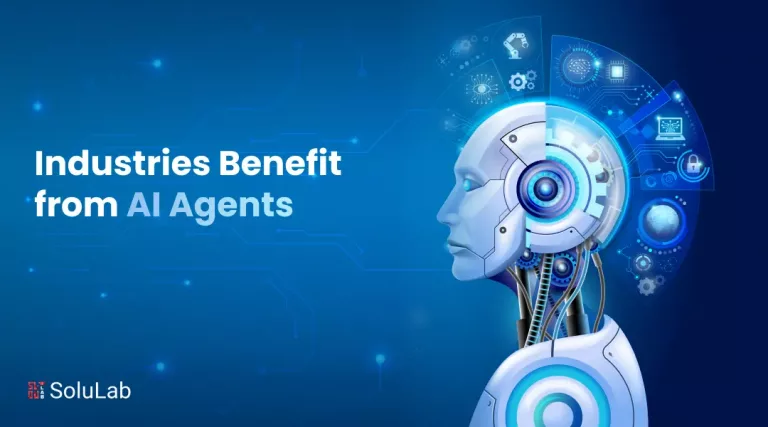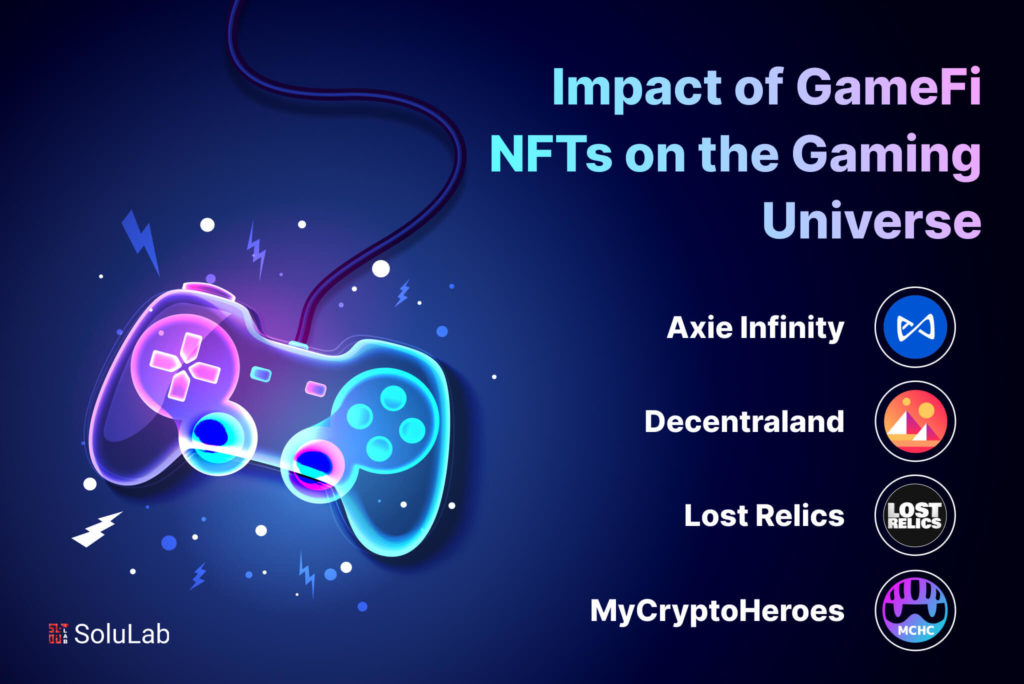
The gaming sector has a rich history of embracing cutting-edge technologies, and the recent surge in GameFi NFTs introduces a thrilling avenue for exploration. The intersection of GameFi and NFTs holds the promise of reshaping player ownership, establishing fresh revenue channels, and inspiring inventive game designs.
In this blog post, we will explore the realm of blockchain gaming, demystify the integral role played by NFTs in video games, and analyze how this fusion is transforming the gaming panorama. So, let’s dive into the world of GameFi NFTs and uncover the latest developments in blockchain gaming.
Keeping Pace With the Evolution of Blockchain Gaming
The synergy between blockchain gaming and the ascent of NFTs has introduced a revolutionary approach to game development, distribution, and monetization. Through blockchain gaming, there is a decentralized governance of game assets, providing players with a level of independence and ownership not found in conventional gaming structures.
The incorporation of NFTs as in-game assets has intensified the momentum of this emerging landscape, unlocking fresh gameplay dynamics and presenting unique value propositions for both players and game developers.
Understanding NFTs in GameFi
NFTs, distinct and indivisible digital assets recorded on a blockchain, play a crucial role in gaming by serving as digital representations of in-game assets, offering players a genuine sense of ownership and influence.
Through the transformation of virtual items into NFTs, players can seamlessly transfer them across different games, trade them on digital marketplaces, or earn rewards through play-to-earn initiatives. The decentralized nature of the blockchain establishes a self-sustaining gaming economy, enabling players to engage as contributors, traders, and creators.
NFTs in GameFi manifest in various forms, primarily falling into:
- In-game assets: These NFTs represent tangible items within a game, such as weapons, skins, characters, and virtual real estate. Each asset comes with distinct attributes, functionalities, and significance in the game’s universe. Tokenizing these assets into NFTs ensures authentic ownership and control for players over their digital belongings.
- Governance tokens: Certain games issue governance tokens as NFTs, endowing players with voting rights and influence over the game’s direction and development. These tokens foster decentralization, enabling players to actively participate in decision-making processes shaping the game’s future in the realm of GameFi.
What is GameFi?
GameFi, a term coined from the fusion of gaming and decentralized finance (DeFi), signifies the amalgamation of blockchain technology and financial mechanisms within gaming. This convergence empowers players to earn rewards, engage in the trade of in-game assets, and participate in decentralized governance structures.
NFTs within the gaming sphere, particularly in the context of GameFi projects, deliver numerous advantages for both players and developers. These distinct digital assets offer genuine ownership and lucrative prospects, characterized by:
- Ownership and Autonomy: NFTs ensure authentic digital ownership, providing players the freedom to manage, trade, or sell their in-game assets according to their preferences.
- Interoperability: NFTs facilitate seamless collaboration across platforms, enabling assets to traverse different games or ecosystems. This not only enhances player experiences but also fosters creativity.
- Monetization: Through the tokenization of in-game assets and the freedom to transfer and trade them, NFTs create new avenues for revenue generation. This benefits developers and players alike, as players can now earn value through their gaming endeavors.
Convergence of Traditional Gaming with Blockchain Technology
The journey of the gaming industry has been remarkable, progressing from the era of arcade machines and basic 8-bit graphics. Technological advancements have propelled gaming from a niche hobby to a global industry worth billions of dollars. Concurrently, the foundational business models and player experiences in gaming have undergone significant transformations.
Conventional gaming typically relies on diverse revenue streams, encompassing the sale of physical or digital game copies, microtransactions within games, and subscription-based earnings for online gaming. In these models, developers and publishers exert substantial control over the digital assets within the game, with players often having restricted rights to utilize or monetize in-game items. The trading of these assets proves challenging and lacks official support beyond certain gaming communities.
The Gaming Industry’s Ongoing Transformation
In recent decades, the gaming sector has undergone substantial expansion and transformation. The integration of cutting-edge technologies such as Virtual Reality (VR), Augmented Reality (AR), and esports has propelled the industry to unprecedented levels, ushering in a new era of inventive gameplay experiences. The infusion of Blockchain Technology and the incorporation of NFTs introduce a novel aspect to gaming, unlocking fresh possibilities for player interaction, engagement, and financial gains.
In the contemporary landscape, the use of NFTs empowers game developers to craft distinct and verifiable digital assets, granting players enhanced control over their in-game possessions. These assets can be exchanged, sold, or utilized across various games and platforms, providing players with increased autonomy and establishing realistic in-game economies. Simultaneously, this evolution creates new avenues for revenue generation, benefitting both developers and players in the gaming ecosystem.
Exploring the GameFi Landscape
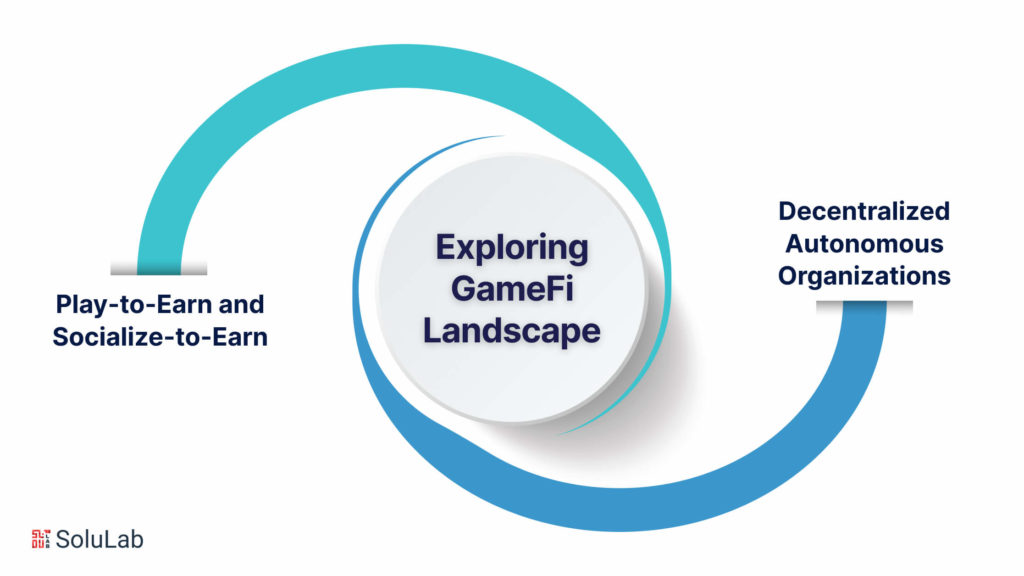
GameFi is positioned to revolutionize the gaming industry, introducing fresh opportunities for player ownership, inventive game development, and revenue generation. By providing players with greater authority over their in-game assets and incorporating innovative mechanics such as play-to-earn, socialize-to-earn, and Decentralized Autonomous Organizations (DAOs), GameFi fundamentally alters the dynamics among developers, players, and games. This transformation signals a more decentralized and democratic future for the gaming sphere.
-
Play-to-Earn and Socialize-to-Earn
The Play-to-Earn model represents a groundbreaking gaming approach, allowing players to earn rewards through active participation, especially in games integrated with blockchain technology. Unlike traditional in-game purchases, Play-to-Earn NFT games enable players to accumulate valuable assets during gameplay, which can subsequently be traded or sold in online marketplaces.
Socialize-to-Earn stands out as an innovative model, placing a strong emphasis on players’ social interactions and engagement within the game. This framework actively encourages players to construct, share, and actively participate in game communities, offering tangible rewards in the form of in-game assets and governance tokens.
-
Decentralized Autonomous Organizations (DAOs)
Frequently incorporated in GameFi initiatives, Decentralized Autonomous Organizations (DAOs) operate based on rules encoded in smart contracts on a blockchain. These entities facilitate decentralized decision-making, typically empowering players and stakeholders to influence game development and other project aspects through voting on proposals, utilizing governance tokens as voting power. This decentralization not only instills a sense of player agency but also nurtures community-driven game development.
DeFi Fusion with Gaming in the GameFi NFTs Realm
An additional dimension of GameFi involves its potential to seamlessly blend DeFi elements into gaming experiences. GameFi and DeFi exhibit numerous commonalities, including decentralized governance, tokenization, and community-driven decision-making.
Through the integration of DeFi into gaming ecosystems, developers unlock novel avenues for players to earn, trade, and invest in assets. Games are increasingly incorporating DeFi tools like liquidity pools, decentralized exchanges (DEXs), and DeFi protocols to cultivate a more dynamic in-game economy.
This amalgamation can manifest in diverse ways, such as enabling players to stake in-game assets for rewards, providing liquidity in game-specific tokens or NFT markets, or even incorporating synthetic assets to introduce innovative in-game mechanics within the realm of GameFi NFTs.
Summing up these components, a variety of gaming ventures have surfaced and achieved acclaim, including Axie Infinity, Decentraland, and iguVerse, to name a few. These initiatives exemplify the capacity of GameFi to revolutionize established gaming frameworks, providing innovative and captivating gaming encounters.
Prominent GameFi Initiatives
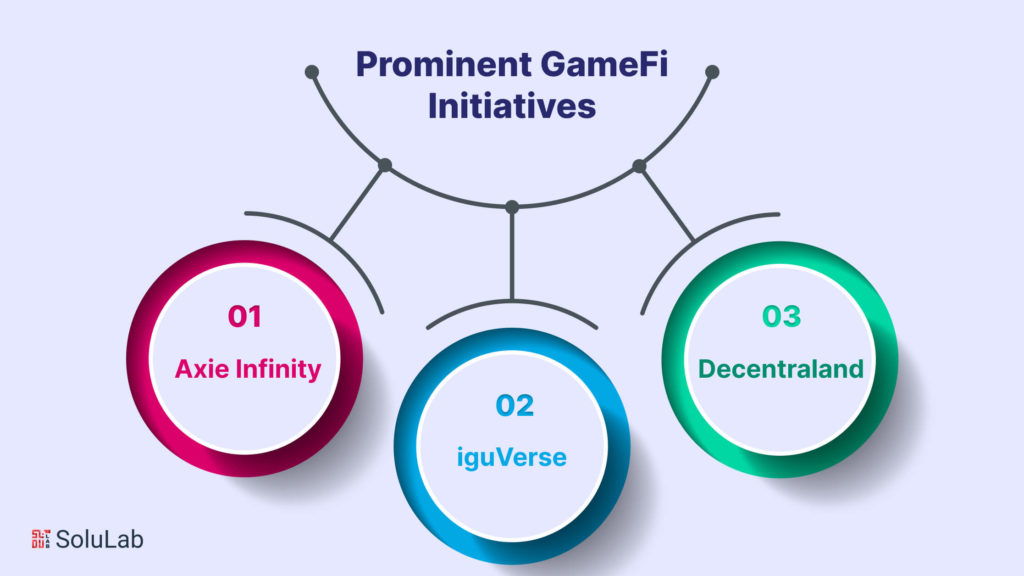
In recent times, several noteworthy GameFi ventures have attracted substantial attention, serving as compelling demonstrations of the capabilities of NFTs and blockchain technology in the gaming realm. Notable among these are Axie Infinity, Decentraland, and iguVerse, exemplifying the viability and influence of this emerging sector.
-
Axie Infinity
Axie Infinity stands out as a blockchain-based game that revolves around the collection, breeding, and battling of fantasy creatures known as Axies. Participants in Axie Infinity can earn rewards in the form of Smooth Love Potion (SLP) tokens by engaging in battles and completing diverse tasks. These tokens are tradable or sellable on cryptocurrency exchanges, or they can be utilized to breed new Axies, subsequently offered as NFTs on the marketplace.
The implementation of the Play-to-Earn model within Axie Infinity has garnered a substantial following, with players not only enjoying the game but also viewing it as a means of generating income. The success of Axie Infinity illustrates how NFT gaming can democratize the industry, providing players with influence through a decentralized and player-centric economy.
-
iguVerse
iguVerse represents a GameFi platform dedicated to establishing an interconnected ecosystem of blockchain-based games. Players have the opportunity to earn rewards and collect NFTs across various games within the iguVerse framework, with the flexibility to trade, sell, or utilize them as interoperable assets in other games on the platform.
This approach underscores the potential of cross-game NFT integration and blockchain gaming, offering a glimpse into a more dynamic and immersive future for the gaming industry. It envisions a scenario where players can seamlessly transition their assets and rewards across multiple games within the iguVerse ecosystem.
-
Decentraland
Decentraland serves as a virtual world built on the Ethereum blockchain, providing users with a platform to create, own, and trade digital assets. At its core, Decentraland leverages NFTs to represent virtual land parcels known as LAND, where users can construct various content, including art galleries, casinos, and games.
The decentralized nature of Decentraland fosters an open economy, enabling players to trade and monetize digital assets such as LAND, wearables, or in-game items. The incorporation of DeFi elements, such as staking and governance, adds complexity to Decentraland’s metaverse experience, showcasing the transformative potential of blockchain and NFTs in the realms of gaming and virtual reality.
These thriving GameFi projects underscore the diverse and promising landscape that NFTs and blockchain technologies are shaping within the gaming industry. As developers increasingly embrace these technologies and players recognize their advantages, the gaming landscape will undoubtedly continue to evolve, pushing the boundaries of what can be achieved.
GameFi’s Journey to Mainstream Acceptance
Major players in the gaming industry, such as Ubisoft, Konami, Atari, and others, have taken strides in the realm of NFT gaming, either by releasing NFT collections or outlining plans to integrate NFTs into their games. However, these endeavors have faced pushback from gamers, developers, and even employees within these companies.
Valve Corporation, the entity behind the widely used digital game distribution platform Steam, has implemented a prohibition on games featuring NFTs or blockchain-based currencies. This resistance highlights a discord between the growing interest in NFTs and gaming and the skepticism persisting across various sectors of the industry.
In contrast, Valve’s competitor, the Epic Games Store, has signaled a willingness to embrace NFT games. This disparity in policies reflects the ongoing uncertainty and debate within the industry about the role and potential impact of NFT in gaming.
Ubisoft, a significant gaming developer and publisher, stands as an illustration of mainstream adoption. The company has already entered the NFT space by establishing its Ubisoft Quartz platform. This platform utilizes the energy-efficient Tezos blockchain to generate, store, and manage in-game NFT assets known as Digits. While Ubisoft’s foray into the NFT gaming realm has faced certain backlash, it underscores the ongoing discourse within the gaming industry concerning the significance of NFTs and their potential for transformation.
Navigating Challenges and Opportunities in GameFi
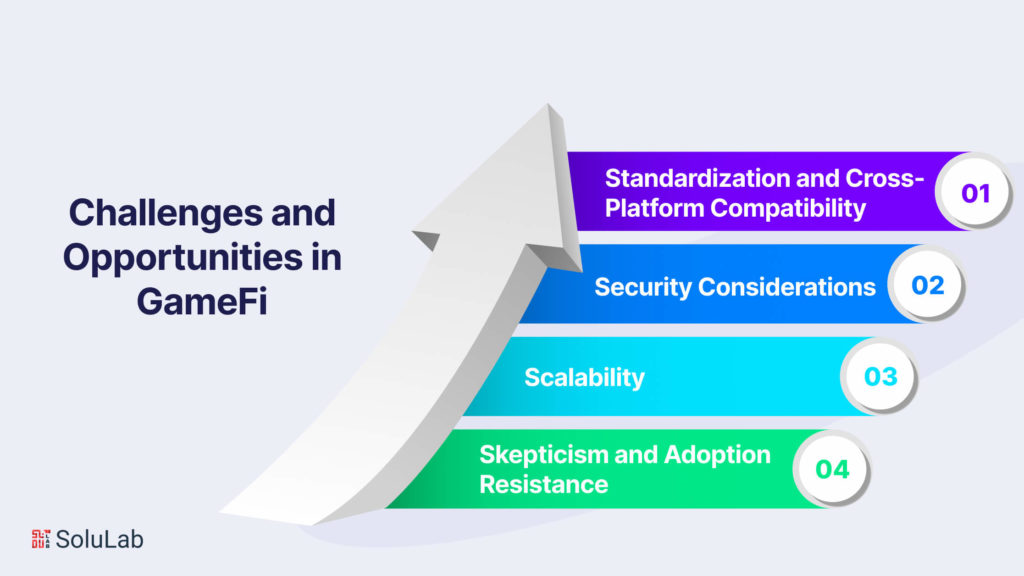
While the potential of NFTs in gaming is evident, several uncertainties and obstacles must be addressed, including standardizing assets across platforms and seamlessly integrating gaming NFT marketplaces. Nonetheless, the gaming industry’s evolution and the increasing interest in NFTs create opportunities for ever-more immersive and interactive gaming experiences.
-
Standardization and Cross-Platform Compatibility
A key challenge in adopting NFTs in gaming revolves around the absence of standardization and cross-platform compatibility. To facilitate smooth trading and transfer of NFT assets across diverse games and platforms, consensus and agreements among game developers are imperative.
Solution: Collaborative efforts among game developers, platforms, and stakeholders can foster industry-wide agreements, laying the groundwork for universal interoperability standards. The introduction of new token standards, such as ERC-1155 for Ethereum, and evolving protocols can establish frameworks supporting cross-platform NFT compatibility.
-
Security Considerations
With the rising popularity and value of NFT assets and blockchain games, security risks escalate. Potential hacks and breaches pose significant financial risks for both developers and players.
Solution: Developers must implement robust security measures, including secure smart contract development, regular audits, and adherence to security best practices. These measures are crucial to safeguarding platforms and players from malicious actors.
-
Scalability
Scalability remains a prominent concern in the blockchain space, influencing the potential growth and adoption of NFTs in gaming. The ability of networks to handle increased demand becomes critical for smooth gameplay and effective asset management as blockchain gaming platforms gain popularity.
Solution: The implementation of Layer 2 scaling solutions, such as sidechains and state channels, can alleviate scalability concerns by offloading transactions and data from the main blockchain. Developers may also explore newer, more scalable blockchain networks better suited for large-scale gaming applications.
-
Skepticism and Adoption Resistance
Skepticism and resistance toward NFTs and blockchain gaming persist among gamers and developers, fueled by controversy and unclear benefits, hindering widespread adoption.
Solution: Raising awareness and educating the gaming community about the advantages and possibilities of NFTs and blockchain gaming is crucial to overcoming resistance. Highlighting successful case studies, like Axie Infinity or Decentraland, and creating more user-friendly gaming experiences can contribute to winning over a broader audience.
While these challenges pose complexities for NFT in gaming, the industry is actively exploring innovative solutions. This ongoing exploration pushes the boundaries of gaming and strengthens the potential for seamless NFT integration.
Influence of GameFi and NFTs on the Gaming Industry
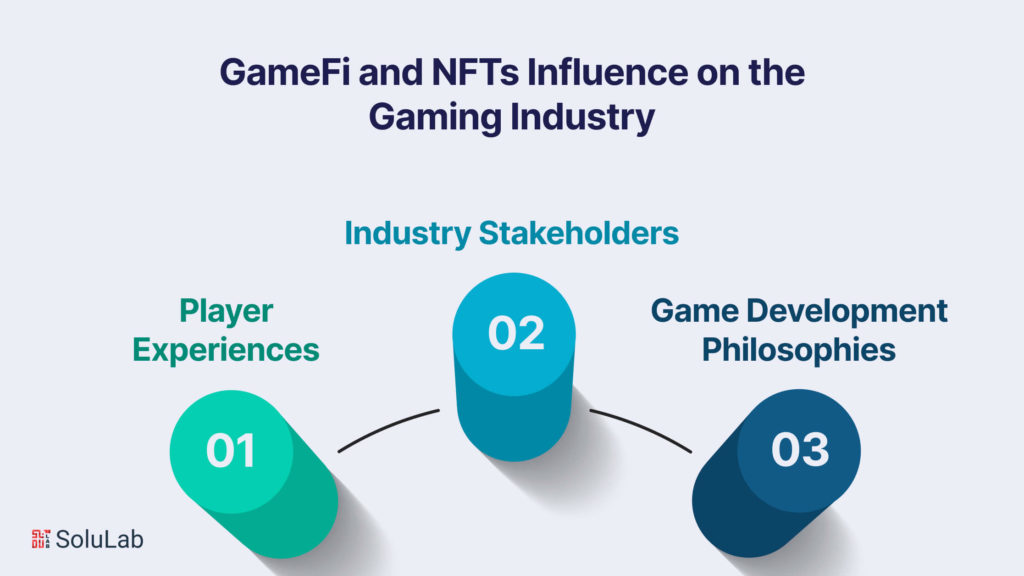
The rise of NFTs and GameFi has ignited substantial interest and advancements in the gaming sector, poised to create far-reaching implications for the industry. The influence of NFTs and GameFi on the gaming arena is discernible through various lenses, encompassing player interactions, industry participants, and the fundamental principles governing game development.
-
Player Experiences
NFTs and GameFi introduce players to unprecedented levels of ownership and influence over in-game assets. As these assets undergo tokenization and become tradeable, players gain the ability to monetize their time, skills, and efforts within games by engaging in buying, selling, or trading digital goods. Notably, the Play-to-Earn model transforms gaming into a source of income for many players, particularly those residing in regions with limited economic opportunities.
Moreover, the cross-chain interoperability and the prospect of transferring NFT assets between games contribute to a more interconnected and adaptable gaming experience. Players are no longer confined to a singular game world, as their distinctive assets can seamlessly travel with them across various platforms and virtual environments.
-
Industry Stakeholders
The ascent of NFTs and GameFi has ushered in new revenue streams and business models for game developers and publishers. This includes the creation, sale, and monetization of NFT assets or the utilization of blockchain-based economies.
However, not all industry stakeholders and gaming communities have universally embraced NFTs and blockchain technology. Concerns regarding environmental impact, financial risks, and potential scams have fueled skepticism and controversy within the gaming industry.
Nevertheless, with advancing technology and the maturation of NFTs and GameFi, industry stakeholders will persist in exploring innovative approaches to gaming that unlock new possibilities for both players and developers.
-
Game Development Philosophies
The introduction of NFTs and GameFi signifies a fundamental shift in game development philosophies, emphasizing player-centric design and the democratization of content creation. Through the tokenization of in-game assets, developers empower players to assume roles as creators, traders, and entrepreneurs within the gaming ecosystem.
This change in approach places increased value in the hands of players, resulting in more substantial interactions with games and providing developers with stronger incentives to craft captivating virtual worlds. It establishes a symbiotic connection between players and developers, where each group contributes to the success and advancement of the other.
Charting the Future Trajectory of GameFi
As GameFi undergoes continuous expansion and gains momentum, several pivotal trends are poised to intricately shape its future, reimagining the gaming landscape. These trends encompass cross-chain interoperability, the incorporation of virtual reality (VR) and augmented reality (AR), and the amalgamation of artificial intelligence (AI) and machine learning within blockchain gaming.
-
Cross-chain Interoperability
The significance of cross-chain interoperability cannot be overstated, as it facilitates seamless interaction and exchange between diverse blockchain networks and their respective assets. In the realm of GameFi, this interoperability translates into a more cohesive and unified gaming experience, enabling players to utilize items, assets, and currencies across various games and platforms effortlessly. VR and AR integration
The domains of virtual and augmented reality hold vast potential for the gaming industry, offering the capability to craft immersive and captivating experiences. When intertwined with NFTs and blockchain technology, VR and AR possess the capacity to further transform the gaming panorama by integrating distinctive digital assets into highly interactive environments.
As VR and AR technologies become more accessible and sophisticated, gaming experiences rooted in the principles of GameFi will continue evolving, presenting players and developers with an unparalleled level of immersion and interaction within virtual worlds.
-
AI and Machine Learning in Blockchain Gaming
Artificial intelligence and machine learning are already making strides in diverse sectors, and gaming is no exception. In the context of GameFi, AI and machine learning can play a pivotal role in enhancing gameplay and establishing highly adaptive, intelligent systems within blockchain-based games.
Innovative applications of AI and machine learning may encompass procedurally generating unique game assets eligible for minting as NFTs, crafting intelligent non-player characters (NPCs) that learn from player interactions, or even shaping entire game worlds that evolve based on player choices.
As GameFi advances, the convergence of these technologies and trends, coupled with NFTs and blockchain, possesses the potential to redefine the gaming future and push the boundaries of immersive, interactive experiences.
Concluding Remarks
NFTs have introduced a surge of creativity and potential in the gaming sector, granting players unprecedented authority and influence over their in-game possessions. The fusion of blockchain technology with gaming is ushering in a novel era, empowering players to engage in decentralized economies, contribute to communities, and monetize their gaming exploits.
While obstacles such as security concerns, standardization issues, and resistance to adoption persist, the growth prospects within this domain are considerable. This transformative journey is steering traditional game development philosophies towards player-centric designs, fostering the democratization of content creation. Ultimately, the ascent of GameFi is not merely transforming our interactions with games; it is fundamentally reshaping the entire gaming industry. It is creating a more inclusive, equitable, and democratic landscape for everyone to partake in and relish.
SoluLab, a NFT game development company, stands at the forefront of GameFi NFT development, offering innovative solutions to empower gaming projects with the transformative potential of blockchain technology. Leveraging our expertise, we provide tailored services to seamlessly integrate NFTs into gaming ecosystems, fostering player-centric experiences and decentralized economies. Whether it’s ensuring cross-chain interoperability, enhancing security measures, or implementing cutting-edge technologies like AI in blockchain gaming, SoluLab is committed to driving the evolution of GameFi. Elevate your gaming venture with SoluLab’s comprehensive GameFi NFT solutions – where innovation meets immersive gameplay. Let’s redefine the future of gaming together. Connect with us today!
FAQs
1. What is GameFi, and how does it differ from traditional gaming?
GameFi, short for Game Finance, represents the integration of blockchain technology and financial mechanisms into gaming. Unlike traditional gaming, GameFi introduces decentralized economies, player ownership of in-game assets as NFTs, and novel revenue streams through play-to-earn models.
2. How do NFTs enhance player experiences in GameFi?
NFTs in GameFi provide players with unparalleled ownership and control over in-game assets. These assets, tokenized on the blockchain, can be traded, sold, or utilized across different games and platforms, introducing a new level of autonomy and monetization for players.
3. What challenges does GameFi face, and how are they being addressed?
Challenges in GameFi include standardization, security concerns, scalability, and skepticism. Solutions involve industry collaborations for standardization, robust security measures, Layer 2 scaling solutions, and heightened awareness and education about the benefits of NFTs in gaming.
4. How does SoluLab contribute to GameFi NFT development?
SoluLab is a leading force in GameFi NFT development, offering tailored solutions to seamlessly integrate NFTs into gaming ecosystems. Our expertise spans cross-chain interoperability, and security enhancements, ensuring a transformative and player-centric gaming experience.
5. What trends are shaping the future of GameFi?
The future of GameFi is influenced by trends such as cross-chain interoperability, the integration of virtual and augmented reality, and the application of Artificial Intelligence and Machine Learning in blockchain gaming. These trends promise to redefine the gaming landscape with more immersive and interactive experiences.




